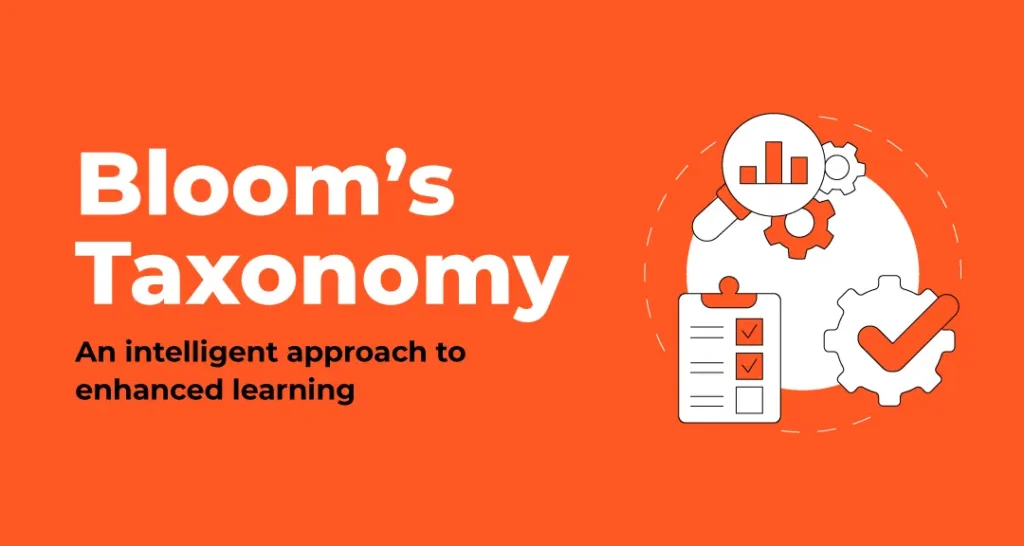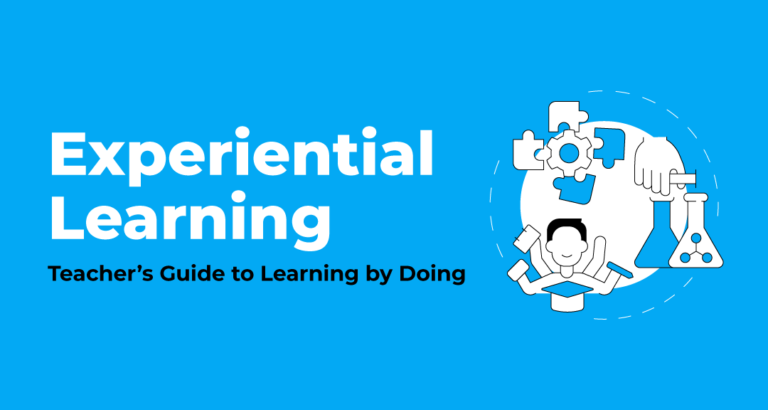Bloom’s Taxonomy: An intelligent approach to enhanced learning
- Teaching
- December 14, 2024
- VOLT Learning

Education is most effective when it nurtures critical thinking, problem-solving and a deep understanding of concepts. This is where Bloom’s Taxonomy comes into play, a framework designed to categorize learning objectives and foster meaningful educational experiences. Developed by Benjamin Bloom and his colleagues in 1956, this taxonomy has revolutionized how we approach teaching, learning and assessment in classrooms worldwide by providing teachers with a structured approach to crafting lessons, designing assessments and evaluating student progress.
Bloom’s Taxonomy emphasises the progression of learning from essential knowledge acquisition to higher-order thinking skills. It’s a tool for educators and a comprehensive guide to creating meaningful and effective educational experiences across disciplines.
This enhanced learning approach operates on the principle that learning is multi-dimensional and evolves through stages. It helps educators identify:
- What learners need to know (Knowledge)
- How they understand it (Comprehension)
- How they can use it (Application)
This systematic approach ensures that teaching goes beyond rote memorisation and encourages learners to analyse, evaluate, and innovate. In 2001, educational researchers like Lorin Anderson and David Krathwohl revised Bloom’s original taxonomy. The updated version shifted from static nouns to dynamic verbs, emphasising action-oriented learning. For instance:
- “Knowledge” became “Remember”, focusing on recalling information
- “Synthesis” became “Create”, emphasising innovation and new ideas
This modernised taxonomy remains widely used in education and training settings, making it a timeless tool for fostering intellectual growth.
What Are the Three Domains of Bloom’s Taxonomy?
Bloom’s Taxonomy is primarily divided into three domains to address different aspects of enhanced learning:
- Cognitive domain to strengthen students’ intellectual abilities and knowledge acquisition, particularly remembering facts and turning the insights to create new ideas.
- The affective domain is used to cope with the learner’s emotions, values, and attitudes. This domain of Bloom’s Taxonomy emphasises how learners engage and respond to the learning material.
- Psychomotor domain to improve their physical skills and coordination abilities in the psychomotor domain. As the name suggests, these skills are crucial for experiencing notable improvements in hands-on learning and practical applications.
These domains ensure a holistic approach to education, balancing knowledge, emotional growth and practical skills.
Why Use Bloom’s Taxonomy?
Bloom’s Taxonomy is more than a theoretical framework; it is a tool that transforms learning by:
- Structuring learning objectives: It helps educators define clear and measurable lesson goals.
- Encouraging higher-order thinking: Moving beyond rote memorisation cultivates analysis, evaluation, and creativity.
- Improving assessments: Teachers can create assessments that measure understanding and applying concepts.
- Enhancing student engagement: The taxonomy’s layered approach ensures that lessons address diverse learning needs, fostering active participation.
How Can Bloom’s Taxonomy Help You Learn More Effectively?
The Cognitive Domain of Bloom’s Taxonomy is the most commonly applied in educational contexts. It consists of six hierarchical levels of thinking, each representing a deeper level of understanding and complexity:
- Remember: Recall facts and basic concepts (e.g., “List the capitals of different countries.”)
- Understand: Explain ideas or concepts in one’s own words (e.g., “Summarize the theory of evolution.”)
- Apply: Use the information in new situations (e.g., “Solve a math problem using a learned formula.”)
- Analyse: Break down information to explore relationships and patterns (e.g., “Differentiate between plant and animal cells.”)
- Evaluate: Make judgments based on criteria and standards (e.g., “Critique an environmental policy’s effectiveness.”)
- Create: Produce new work or ideas (e.g., “Design a model of an eco-friendly home.”)
This progression ensures learners move from foundational knowledge to advanced critical thinking and problem-solving.
Bloom’s Taxonomy in VOLT Books: Redefining Learning for Students
At VOLT, education should not just inform but transform. This belief aligns perfectly with Bloom’s Taxonomy, the cornerstone of our educational philosophy. Social Studies, Mathematics, Science and Environmental Studies (EVS) in VOLT Books are meticulously designed to follow Bloom’s Taxonomy, ensuring a structured yet engaging learning experience.
Case in point: VOLT Mathematics

In our VOLT Mathematics books, we have effectively incorporated Bloom’s Taxonomy. We have divided the chapters into organized and fun-based educational content. Each chapter is conceptually constructed to reflect the levels of Bloom’s Taxonomy from level 1 to level 6, keeping in mind all aspects of learning are addressed. The result—each chapter of VOLT Mathematics encourages theoretical knowledge coupled with practical application and critical thinking.
Let’s explore how this approach is implemented in a typical chapter with an example:
1. Remember: The chapter begins with fundamental concepts and definitions to build a strong foundation, emphasising remembering key facts, formulas, and definitions. This stage ensures that students grasp the foundational knowledge required to advance through the subject. It also helps establish a base layer of understanding by focusing on memory-based tasks.
Example: “Define permeter and area.”
2. Understand: Next, the chapter introduces scenarios where students interpret and explain these concepts. Once the foundation is laid, the chapter moves to comprehension tasks that encourage students to explain concepts in their own words. This step fosters a deeper grasp of the material, bridging the gap between memorisation and understanding. It encourages students to interpret and articulate their knowledge, preparing them for practical applications.
Example: “Explain why calculating area is crucial in real-life contexts, such as construction.”
3. Apply: At this stage, students apply their understanding to solve problems and practice learned concepts. These tasks often reflect real-world scenarios, making learning more relatable and impactful. Here, the focus is reinforcing knowledge through practical application, helping students see the relevance of mathematics in everyday life.
Example: “Calculate the area of a rectangular garden measuring 10m x 15m.”
4. Analyse: The chapter progresses to questions that require students to identify patterns or relationships. In the analysis phase, students are tasked with breaking down information and exploring relationships. This step enhances critical thinking and problem-solving skills. This stage primarily focuses on improving students’ capabilities to evaluate data, make connections, and draw meaningful conclusions.
Example: “Compare the areas of two gardens and determine which is larger.”
5. Evaluate: As the name indicates, the evaluation stage pushes students to assess solutions critically, justify their answers, and make informed decisions. This higher-order thinking stage helps refine logical reasoning and judgment skills. Students are engaged in thinking critically about their solutions and defending their reasoning.
Example: “Evaluate whether planting certain crops is feasible based on available land area.”
6. Create: Finally, students are tasked with designing their problems or projects. In each chapter, VOLT Mathematics tries to empower students to innovate by designing their problems, projects, or solutions. This step nurtures creativity and promotes independent thinking, enabling students to synthesise knowledge and apply the concepts learned to open-ended and creative tasks.
Example: “Design a blueprint for a park layout, including accurate calculations of various sections.”
Interestingly, we at VOLT structure chapters to ensure a gradual progression of learning, from basic recall to advanced problem-solving. This layered structure also ensures a gradual yet comprehensive learning journey that challenges students to think beyond the basics while providing alignment with real-world applications.
Conclusion: Viva VOLT Books and Bloom’s Taxonomy
VOLT Books integrates Bloom’s Taxonomy to cultivate a learning environment prioritising deep understanding, critical thinking, and creativity. VOLT empowers educators and engages students meaningfully by organising chapters across subjects like Social Studies, Mathematics, Science, and EVS to align with Bloom’s levels.
Experience the power of structured learning and transform education with VOLT Books. Explore our collection today and revolutionise your classroom experience!



